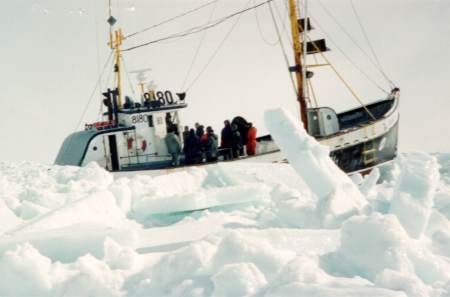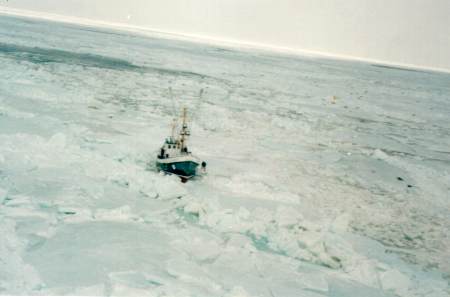Sinking
of the Fishing Vessel "GILBERT D."
off Îles de la Madeleine, Quebec
The Transportation Safety Board of Canada (TSB) investigated this occurrence for the purpose of advancing transportation safety. It is not the function of the Board to assign fault or determine civil or criminal liability. This report is not created for use in the context of legal, disciplinary or other proceedings. See Ownership and use of content. Masculine pronouns and position titles may be used to signify all genders to comply with the Canadian Transportation Accident Investigation and Safety Board Act (S.C. 1989, c. 3).
Summary
On 16 March 1997, the opening of seal hunting season was marked by the sinking of the "GILBERT D." after she was trapped in the ice during the night. The eight crew members were transferred to another vessel and later transported safely to land by helicopter.
Ce rapport est également disponible en français.
Factual information
Particulars of the vessel
| Name | "GILBERT D." |
|---|---|
| Official number | 314179 |
| Port of registry | Cap-aux-Meules |
| Flag | Canada |
| Type | Fishing vessel |
| Gross Tons | 49 |
| Length | 17.34 m |
| Draught | 2.6 m |
| Built | 1961, Gaspé, Quebec |
| Propulsion | One 169 kW diesel engine driving a fixed-pitch propeller |
| Crew | 8 hunters |
| Owners | Henri Fred Poirier Havre-aux-Maisons Îles de la Madeleine, Quebec |
The fishing vessel "GILBERT D." is constructed of wood covered with glass fibre reinforced plastic. On 15 March 1997, at approximately 0345Footnote 1, as a small fleet was preparing to leave Cap-aux-Meules for the seal hunting ground north of the islands, a Canadian Coast Guard icebreaker went ahead of the fleet and cleared a path from Pointe de l'est to open water to facilitate passage to their destination. The vessels, including the "GILBERT D.", wanted to reach the hunting ground by evening.
When the fleet arrived at the hunting ground, four vessels were in an area of open water measuring approximately 0.75 nautical miles (M). The four vessels planned to spend the night there and start hunting at first light. During the night, the winds were blowing from the north at 40 to 50 knots. On the morning of 16 March 1997, the ice had moved in and trapped the "GILBERT D." and "JEAN MATHIEU" in the area of open water, which was now filled with ice.
The pressure of the ice on the hulls of the two vessels lifted the bow of the "GILBERT D.", but the stern was caught in the ice and the hull was stove in in way of the engine compartment. The crew members surveyed the damage and concluded that the engine compartment would be flooded when the ice pressure receded, that the "GILBERT D." would go down and that they could not save her. Nothing could be done to prevent the sinking, and as anticipated, the "GILBERT D." went down quickly on 16 March 1997, at about 1610. There were no injuries and no apparent pollution.
The crew members of the "GILBERT D.", who were now on the ice, were transferred to the fishing vessel "BEL ESPOIR" and later transported to the islands by a Canadian Coast Guard helicopter.
The inspection certificate of the "GILBERT D." was issued on 28 October 1993 and was valid until 01 December 1995. The vessel had not gone out during the 1996 fishing season, as the owner took delivery of a new steel fishing vessel to replace the "GILBERT D.". However, at the owner's request, the certificate of the "GILBERT D." was extended to 27 October 1997 following a hull inspection on 26 February 1997.
Inspection certificates for small fishing vessels are normally valid for four years. However, the certificate issued in 1993 was a short-term inspection certificate good for only two years. It was apparently decided that a short-term certificate should be issued because some equipment on the "GILBERT D." needed to be repaired or replaced. Furthermore, the certificate carried a restriction requiring that fishing voyages be limited to 60 M from the coast.
All permits bear the name of the vessel to be used in the hunt. According to Fisheries and Oceans Canada, permit holders are not authorized to use any vessel other than the one for which the permit is issued. The only requirement that Fisheries and Oceans Canada has for the issuance of a permit is that the length of the vessel not exceed 20 m. The certificate did not carry any restrictions regarding the operation of the "GILBERT D." in ice.
The Canada Shipping Act defines "fishing vessel" as
- a ship that is employed in catching fish, whales, seals, walrus or other living resources of the sea, and that does not carry passengers or cargo.
The "GILBERT D." held a valid SIC 29 at the time of the sinking. Under the Canada Shipping Act, seal hunting is considered a fishing operation, and the inspection certificate carries no restrictions relating to ice navigation.
A seaworthy vessel is fit for navigation on the sea or a navigable waterway. A vessel must not be put out to sea unless she is seaworthy. After a vessel is inspected by a maritime authority, a certificate is issued to certify that the vessel meets the applicable standards for construction and safety and is seaworthy. The vessel must be appropriately built, equipped and crewed for the task intended.
Transport Canada Ship Safety is aware that fishing vessels at Îles de la Madeleine are used in winter seal hunting in ice-infested waters. Fishing vessels that are used for fishing are not designed or strengthened for navigation in ice-infested waters. The practice is apparently tolerated by Transport Canada Ship Safety.
Analysis
Ice can stop any vessel, even an icebreaker, and mariners who are not experienced in ice navigation should learn to respect the latent power of ice in all its forms. However, a serviceable and properly equipped vessel in the hands of a skilled operator can navigate safely in ice-infested waters.
The first rule of ice navigation is to maintain freedom of movement, because when a vessel is imprisoned in ice, she can be moved about by the ice. At the time of year when this occurrence happened, ice conditions off Îles de la Madeleine are difficult and vessels operating in the area must be cautious.
Since there are no regulations prescribing design minima for fishing vessels used in fishing or hunting operations in the ice, the only prerequisite for a seal hunting permit is the minimum length requirement.
Navigating in ice can be extremely difficult, as mariners must always be on the lookout for new open water passages. Mariners are referred to the Canadian Coast Guard publication Ice Navigation in Canadian Waters (TP 5064). It contains valuable information and lists the services that may be required when navigating in Canadian ice-infested waters. It offers helpful advice to anyone contemplating a voyage during the ice season.
Fisheries and Oceans Canada does not issue instructions regarding the operation of a fishing vessel in ice. However, its principal mandate, in cooperation with the Canadian Coast Guard, is to ensure that fishing operations can be carried on safely and in such a manner that crews are not involved in operations that could prove hazardous, irrespective of the conditions. There are no regulations requiring fishing vessels used in seal hunting in ice-infested waters to be designed for operations in adverse weather conditions.
Given the economic significance of seal hunting at Îles de la Madeleine, it is necessary that hunters be able to carry on hunting safely with vessels designed to withstand the adverse sailing conditions encountered during the ice season. Seaworthiness is an important aspect of safety for vessels and crews to avoid instances of negligence with regard to vessel design, maintenance and operation.
Findings
- The "GILBERT D." was crushed by ice pressure after taking shelter in an area of open water for the night.
- The "GILBERT D." was not seaworthy for the type of operation on which she was employed.
- The wooden hull covered with glass fibre reinforced plastic was unable to withstand the ice pressure.
- With the exception of the maximum length requirement of 20 m, Fisheries and Oceans Canada has no criteria for issuing seal hunting permits to fishing vessels.
- The inspection certificate (SIC 29) issued to the "GILBERT D." by Transport Canada carried only one restriction, namely that fishing voyages be limited to 60 M from the coast.
- The SIC 29 carried no restriction regarding the use of the "GILBERT D." for hunting seals on the ice.
- Transport Canada Ship Safety appears to tolerate seal hunting with vessels that are not seaworthy for this type of operation.
- The crew members could do nothing to prevent the sinking of the "GILBERT D.".
- A Canadian Coast Guard helicopter that was overflying the area picked up the eight crew members and transported them safely to land.
- Seal hunting is considered a fishing operation under the Canada Shipping Act .
- Fisheries and Oceans Canada issues hunting permits to vessels which are not designed for ice navigation.
Causes and Contributing Factors
The loss of the "GILBERT D." was the result of extreme ice pressure on the hull; the ice was propelled by a moderate gale while the vessel was sheltering for the night in an area of open water. The vessel was not seaworthy for ice navigation.
This report concludes the Transportation Safety Board's investigation into this occurrence. Consequently, the Board, consisting of Chairperson, Benoît Bouchard, and members Maurice Harquail, Charles Simpson and W. A. Tadros, authorized the release of this report on .

